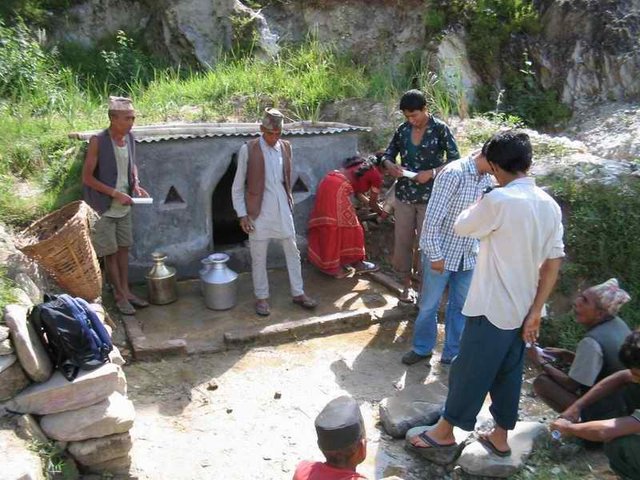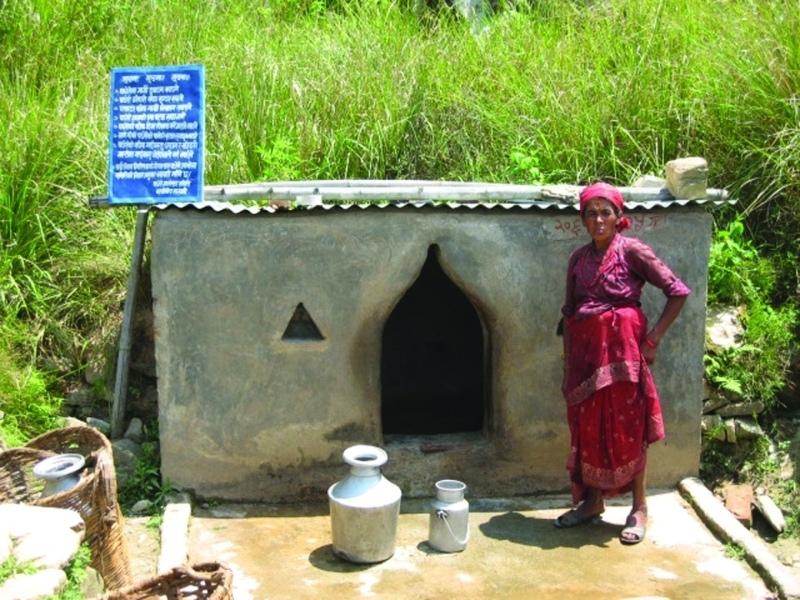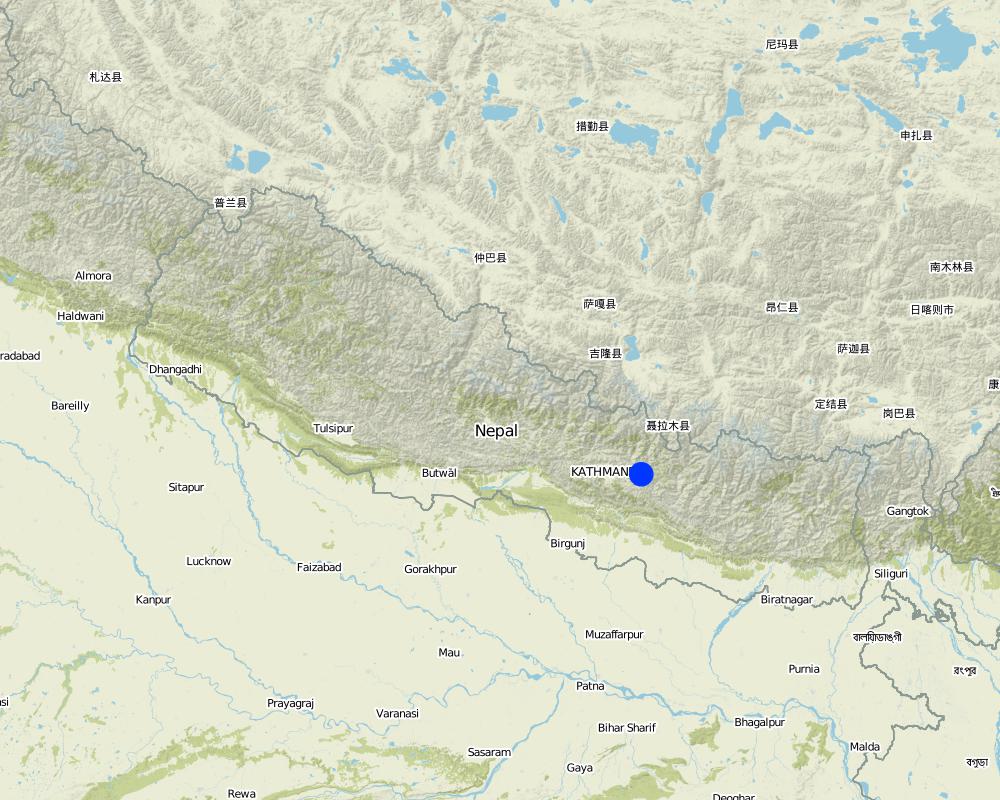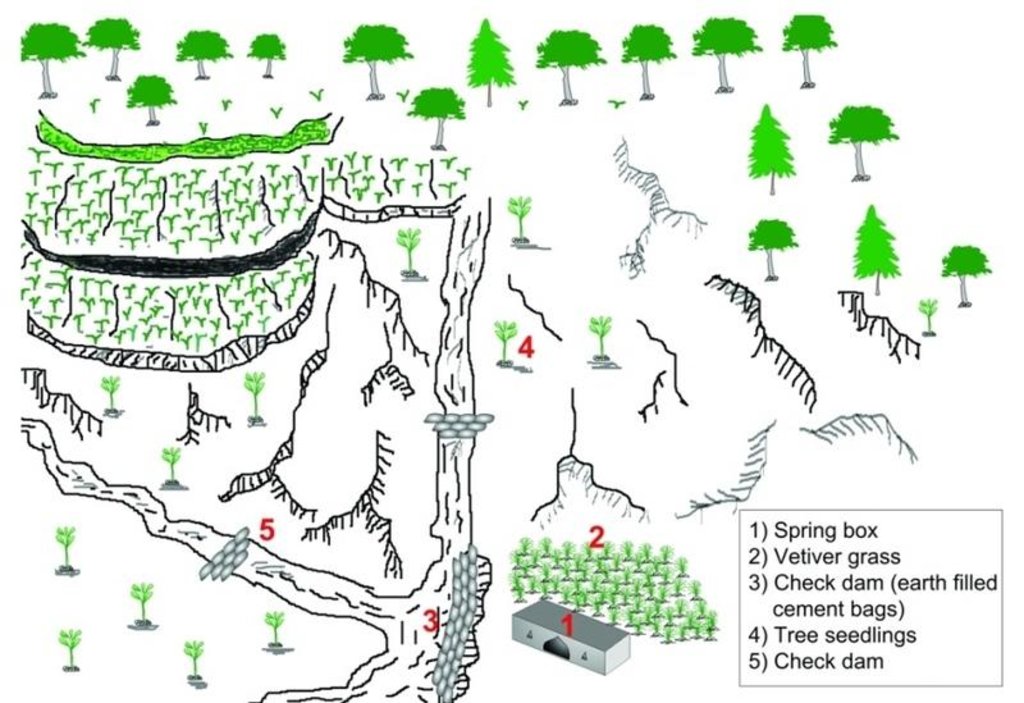Drinking water quality improvement through conservation measures [เนปาล]
- ผู้สร้างสรรค์:
- การอัพเดท:
- ผู้รวบรวม: Madhav Dhakal
- ผู้เรียบเรียง: –
- ผู้ตรวจสอบ: David Streiff, Alexandra Gavilano
Samrakshan bidhi dwara piune pani ko gunastar sudhar - Nepali
technologies_1496 - เนปาล
ดูส่วนย่อย
ขยายทั้งหมด ย่อทั้งหมด1. ข้อมูลทั่วไป
1.2 รายละเอียดที่ติดต่อได้ของผู้รวบรวมและองค์กรที่เกี่ยวข้องในการประเมินและการจัดเตรียมทำเอกสารของเทคโนโลยี
ผู้เชี่ยวชาญ SLM:
ผู้เชี่ยวชาญ SLM:
ผู้เชี่ยวชาญ SLM:
Dongol Bhawani
เนปาล
ชื่อของโครงการซึ่งอำนวยความสะดวกในการทำเอกสารหรือการประเมินเทคโนโลยี (ถ้าเกี่ยวข้อง)
People and Resource Dynamics Project, Nepal (PARDYP)ชื่อขององค์กรซึ่งอำนวยความสะดวกในการทำเอกสารหรือการประเมินเทคโนโลยี (ถ้าเกี่ยวข้อง)
ICIMOD International Centre for Integrated Mountain Development (ICIMOD) - เนปาล1.3 เงื่อนไขการใช้ข้อมูลที่ได้บันทึกผ่านทาง WOCAT
ผู้รวบรวมและวิทยากรหลักยอมรับเงื่อนไขเกี่ยวกับการใช้ข้อมูลที่ถูกบันทึกผ่านทาง WOCAT:
ใช่
1.5 Reference to Questionnaire(s) on SLM Approaches (documented using WOCAT)

Community efforts for improving drinking water quality [เนปาล]
Working with communities to demonstrate and disseminate methods for improving drinking water quality using structural and vegetative measures
- ผู้รวบรวม: Madhav Dhakal
2. การอธิบายลักษณะของเทคโนโลยี SLM
2.1 การอธิบายแบบสั้น ๆ ของเทคโนโลยี
คำจำกัดความของเทคโนโลยี:
Structural and vegetative measures to improve the quality of drinking water contaminated due to poor sanitation and seepage
2.2 การอธิบายแบบละเอียดของเทคโนโลยี
คำอธิบาย:
This technology combines structural and vegetative measures to improve the quality of drinking water in an open spring. The quality of water was deteriorating due to poor sanitation and seepage around the spring. The spring was located near to Dhotra village at Barbot sub-settlement, Kabhrepalanchok district. About five households depended on the spring for their drinking water supplies with a further 10 using it regularly and 10-15 using it occasionally during the dry season.
The main purpose of implementing the technology was to improve the quality of drinking water in the spring by preventing it from being contaminated by surface runoff during the rainy season. This technology has long been implemented across Nepal’s midhills. In this case a development project (PARDYP) mobilised the users and provided them with technical and material support to make the improvements.
A spring user group was formed. With project help, it built a walled structure (a spring box) over the spring and check dams around the spring, and planted grasses around the spring box and trees in the catchment. These measures prevented the direct flow of surface water into the spring thus reducing contamination and turbidity. Users built a 1.8m long, 1m wide and 1.5m high spring box with a zinc sheeted roof. Check dams were built across the surrounding gullies and rills. A main 2.5m long, 0.5m wide, and 1m high check dam was constructed near the source to prevent surface runoff from entering the spring. A drainage channel was made to drain off wastewater. Vetiver grass seedlings were planted around the spring box and trees were planted in the adjoining catchment. These activities were carried out at the beginning of the rainy season.
This technology is simple and durable and the only maintenance needed is to keep the surroundings clean and to repair any damage.
The case study area receives about 1200 mm of annual precipitation of which about 80% occurs during the monsoon season (June to September). The area mostly has red soils which are highly weathered and, if not managed properly, are very susceptible to erosive processes.
2.3 รูปภาพของเทคโนโลยี
2.5 ประเทศภูมิภาค หรือสถานที่ตั้งที่เทคโนโลยีได้นำไปใช้และได้รับการครอบคลุมโดยการประเมินนี้
ประเทศ:
เนปาล
ภูมิภาค/รัฐ/จังหวัด:
Kavrepalanchowk district/ Jhikhu Khola watershed
ระบุการกระจายตัวของเทคโนโลยี:
- กระจายไปอย่างสม่ำเสมอในพื้นที่
If precise area is not known, indicate approximate area covered:
- < 0.1 ตร.กม.(10 เฮกตาร์)
Map
×2.6 วันที่การดำเนินการ
ถ้าไม่รู้ปีที่แน่นอน ให้ระบุวันที่โดยประมาณ:
- มากกว่า 50 ปี (แบบดั้งเดิม)
2.7 คำแนะนำของเทคโนโลยี
ให้ระบุว่าเทคโนโลยีถูกแนะนำเข้ามาอย่างไร:
- ทางโครงการหรือจากภายนอก
ความคิดเห็น (ประเภทของโครงการ เป็นต้น) :
Local community, with the contribution from individual community members or from external support have been implementing since generations. In this particular case project mobilized the spring users community and assisted them by providing technical and material support during programme implementing period.
3. การจัดประเภทของเทคโนโลยี SLM
3.1 วัตถุประสงค์หลักของเทคโนโลยี
- Improve water quality
3.2 ประเภทของการใช้ที่ดินในปัจจุบันที่ได้นำเทคโนโลยีไปใช้

ทุ่งหญ้าเลี้ยงสัตว์

อื่น ๆ
ระบุ:
Private land-abondent by village elite, communal land-open grazing
แสดงความคิดเห็น:
Major land use problems (compiler’s opinion): High pressure on limited land resources due to overuse of crop, forest, and grazing lands; increased inputs of agrochemicals which will lead to the deterioration of drinking water quantity and quality
Major land use problems (land users’ perception): Water quality deterioration resulting from poor sanitation
Constraints of wastelands / deserts / glaciers / swamps: private land-abondent by village elite, communal land-open grazing
Number of growing seasons per year: 3
Longest growing period in days: 150; Longest growing period from month to month: Jun - Oct; Second longest growing period in days: 120; Second longest growing period from month to month: Nov - Feb
3.5 กลุ่ม SLM ที่ตรงกับเทคโนโลยีนี้
- การจัดการน้ำผิวดิน (น้ำพุ แม่น้ำทะเลสาบ ทะเล)
3.6 มาตรการ SLM ที่ประกอบกันเป็นเทคโนโลยี

มาตรการอนุรักษ์ด้วยวิธีพืช
- V2: หญ้าและไม้ยืนต้น

มาตรการอนุรักษ์ด้วยโครงสร้าง
- S5: เขื่อน ชั้นดินที่แน่นแข็งบ่อน้ำ
แสดงความคิดเห็น:
Main measures: vegetative measures, structural measures
Type of vegetative measures: scattered / dispersed
3.7 รูปแบบหลักของการเสื่อมโทรมของที่ดินที่ได้รับการแก้ไขโดยเทคโนโลยี

การกัดกร่อนของดินโดยน้ำ
- Wo (Offsite degradation): ผลกระทบนอกพื้นที่
แสดงความคิดเห็น:
Main causes of degradation: overgrazing (uncontrolled access to grazing land), other natural causes (avalanches, volcanic eruptions, mud flows, highly susceptible natural resources, extreme topography, etc.) specify (concentrated runoff during rainy season), education, access to knowledge and support services (lack of knowledge - water quality treatment)
Secondary causes of degradation: deforestation / removal of natural vegetation (incl. forest fires) (uncontrolled access to forest land), poverty / wealth (lack of captial - conservation activities)
3.8 การป้องกัน การลดลง หรือการฟื้นฟูความเสื่อมโทรมของที่ดิน
ระบุเป้าหมายของเทคโนโลยีกับความเสื่อมโทรมของที่ดิน:
- ลดความเสื่อมโทรมของดิน
4. ข้อมูลจำเพาะด้านเทคนิค กิจกรรมการนำไปปฏิบัติใช้ ปัจจัยนำเข้า และค่าใช้จ่าย
4.1 แบบแปลนทางเทคนิคของเทคโนโลยี
ข้อมูลจำเพาะด้านเทคนิค (แบบแปลนทางเทคนิคของเทคโนโลยี):
Structural and vegetative measures applied to improvewater quality of spring
Location: Barbot Dhotra. Kabhrepalanchowk district
Technical knowledge required for field staff / advisors: moderate
Technical knowledge required for land users: moderate
Main technical functions: control of concentrated runoff: impede / retard, improvement of ground cover
Secondary technical functions: increase / maintain water stored in soil
Scattered / dispersed
Vegetative material: T : trees / shrubs, G : grass
Trees/ shrubs species: Michelia champaca
Grass species: Vetiveria lawsoni
Structural measure: spring box wall
Material: concrete
Height of bunds/banks/others (m): 1.5
Width of bunds/banks/others (m): 1.02
Length of bunds/banks/others (m): 1.89
Structural measure: check dams
Height of bunds/banks/others (m): 1
Width of bunds/banks/others (m): 0.5
Length of bunds/banks/others (m): 2.5
Structural measure: cut-off drain
Material: Stone
Depth of ditches/pits/dams (m): 0.2
Width of ditches/pits/dams (m): 0.25
Length of ditches/pits/dams (m): 3
Construction material (stone): locally available
Construction material (concrete): cement, sand, brick
ผู้เขียน:
Madhav Dhakal, A. K.Thaku
4.2 ข้อมูลทั่วไปเกี่ยวกับการคำนวณปัจจัยนำเข้าและค่าใช้จ่าย
ให้ระบุว่าค่าใช้จ่ายและปัจจัยนำเข้าได้รับการคำนวณอย่างไร:
- ต่อหน่วยเทคโนโลยี
โปรดระบุหน่วย:
Spring box and plants
Specify dimensions of unit (if relevant):
1.8m long, 1m wide and 1.5m high with a zinc sheeted roof
ระบุสกุลเงินที่ใช้คำนวณค่าใช้จ่าย:
- USD
ระบุค่าเฉลี่ยของค่าจ้างในการจ้างแรงงานต่อวัน:
1.60
4.3 กิจกรรมเพื่อการจัดตั้ง
| กิจกรรม | Timing (season) | |
|---|---|---|
| 1. | Planting vetiver grass around the spring box | beginning of rainy season |
| 2. | Planting tree species in the catchment | beginning of rainy season |
| 3. | Building of check dams to divert stream and gully runoff water | start of the rainy season |
| 4. | Buildingof the spring box | start of the rainy season |
| 5. | Construction of concrete floor in front of spring box | start of the rainy season |
| 6. | Construction of drainage channel | start of the rainy season |
4.4 ค่าใช้จ่ายของปัจจัยนำเข้าที่จำเป็นสำหรับการจัดตั้ง
| ปัจจัยนำเข้า | หน่วย | ปริมาณ | ค่าใช้จ่ายต่อหน่วย | ค่าใช้จ่ายทั้งหมดต่อปัจจัยนำเข้า | %ของค่าใช้จ่ายที่ก่อให้เกิดขึ้นโดยผู้ใช้ที่ดิน | |
|---|---|---|---|---|---|---|
| แรงงาน | Building spring box and planting trees | Persons/day | 69.0 | 1.6 | 110.4 | 80.0 |
| วัสดุด้านพืช | Grass seedlings | unit | 1.0 | 4.0 | 4.0 | |
| วัสดุสำหรับก่อสร้าง | Cement | unit | 1.0 | 44.0 | 44.0 | |
| วัสดุสำหรับก่อสร้าง | Gravel / sand | unit | 1.0 | 55.0 | 55.0 | 100.0 |
| วัสดุสำหรับก่อสร้าง | Bricks | unit | 1.0 | 188.0 | 188.0 | |
| วัสดุสำหรับก่อสร้าง | Empty sacks | unit | 1.0 | 5.0 | 5.0 | |
| วัสดุสำหรับก่อสร้าง | Tinc sheet | unit | 1.0 | 16.0 | 16.0 | |
| วัสดุสำหรับก่อสร้าง | Steel wire | unit | 1.0 | 1.0 | 1.0 | |
| วัสดุสำหรับก่อสร้าง | Transportation | unit | 1.0 | 10.0 | 10.0 | 15.0 |
| ค่าใช้จ่ายทั้งหมดของการจัดตั้งเทคโนโลยี | 433.4 | |||||
| Total costs for establishment of the Technology in USD | 433.4 | |||||
ถ้าผู้ใช้ที่ดินรับภาระน้อยกว่า 100% ของค่าใช้จ่าย ให้ระบุว่าใครเป็นผู้รับผิดชอบส่วนที่เหลือ:
PARDYP and District Development Committee
แสดงความคิดเห็น:
Duration of establishment phase: 12 month(s)
4.5 การบำรุงรักษาสภาพหรือกิจกรรมที่เกิดขึ้นเป็นประจำ
| กิจกรรม | ช่วงระยะเวลา/ความถี่ | |
|---|---|---|
| 1. | replacement/ gap filling with new tree seedings | /as required |
| 2. | maintaining height of the planted grass | /as required |
| 3. | Cleaning spring box surroundings | as per need |
| 4. | Maintenance of wall/ floor against damage | as per need |
| 5. | Maintenance of check dam against damage | as per need |
4.6 ค่าใช้จ่ายของปัจจัยนำเข้าและกิจกรรมที่เกิดขึ้นเป็นประจำที่ต้องการการบำรุงรักษา (ต่อปี)
| ปัจจัยนำเข้า | หน่วย | ปริมาณ | ค่าใช้จ่ายต่อหน่วย | ค่าใช้จ่ายทั้งหมดต่อปัจจัยนำเข้า | %ของค่าใช้จ่ายที่ก่อให้เกิดขึ้นโดยผู้ใช้ที่ดิน | |
|---|---|---|---|---|---|---|
| แรงงาน | Maintaining springbox | Persons/day | 2.0 | 1.6 | 3.2 | 100.0 |
| ค่าใช้จ่ายทั้งหมดของการบำรุงรักษาสภาพเทคโนโลยี | 3.2 | |||||
| Total costs for maintenance of the Technology in USD | 3.2 | |||||
แสดงความคิดเห็น:
Machinery/ tools: hoe,spade, shovel, nails, hammer, pliers, trowel, steel pan bucket, and jug
The cost is only for unit technology, it can not be extrapolated to hector basis, as in 2006.
4.7 ปัจจัยสำคัญที่สุดที่มีผลกระทบต่อค่าใช้จ่าย
ปัจจัยสำคัญที่สุดที่มีผลกระทบต่อค่าใช้จ่ายต่างๆ:
Material cost was comparatively high followed by labor cost. For this technology several actors contributed. The land users contributed 61 percent, District Development Committee contributed 26 percent and PARDYP contributed 13 percent, and the department of forest and PARDYP regional coordinator contributed by providing planting materials( vetiver).
5. สิ่งแวดล้อมทางธรรมชาติและของมนุษย์
5.1 ภูมิอากาศ
ฝนประจำปี
- < 250 ม.ม.
- 251-500 ม.ม.
- 501-750 ม.ม.
- 751-1,000 ม.ม.
- 1,001-1,500 ม.ม.
- 1,501-2,000 ม.ม.
- 2,001-3,000 ม.ม.
- 3,001-4,000 ม.ม.
- > 4,000 ม.ม.
ระบุปริมาณน้ำฝนเฉลี่ยรายปี (ถ้ารู้) :หน่วย ม.ม.
1200.00
เขตภูมิอากาศเกษตร
- ชื้น
Thermal climate class: subtropics
5.2 สภาพภูมิประเทศ
ค่าเฉลี่ยความลาดชัน:
- ราบเรียบ (0-2%)
- ลาดที่ไม่ชัน (3-5%)
- ปานกลาง (6-10%)
- เป็นลูกคลื่น (11-15%)
- เป็นเนิน (16-30%)
- ชัน (31-60%)
- ชันมาก (>60%)
ธรณีสัณฐาน:
- ที่ราบสูง/ที่ราบ
- สันเขา
- ไหล่เขา
- ไหล่เนินเขา
- ตีนเนิน
- หุบเขา
ระดับความสูง:
- 0-100 เมตร
- 101-500 เมตร
- 501-1,000 เมตร
- 1,001-1,500 เมตร
- 1,501-2,000 เมตร
- 2,001-2,500 เมตร
- 2,501-3,000 เมตร
- 3,001-4,000 เมตร
- > 4,000 เมตร
ความคิดเห็นและข้อมูลจำเพาะเพิ่มเติมเรื่องสภาพภูมิประเทศ:
Altitudinal zone: 900 m a.s.l.
5.3 ดิน
ค่าเฉลี่ยความลึกของดิน:
- ตื้นมาก (0-20 ซ.ม.)
- ตื้น (21-50 ซ.ม.)
- ลึกปานกลาง (51-80 ซ.ม.)
- ลึก (81-120 ซ.ม.)
- ลึกมาก (>120 ซ.ม.)
เนื้อดิน (ดินชั้นบน):
- ละเอียด/หนัก (ดินเหนียว)
อินทรียวัตถุในดิน:
- ต่ำ (<1%)
(ถ้ามี) ให้แนบคำอธิบายเรื่องดินแบบเต็มหรือระบุข้อมูลที่มีอยู่ เช่น ชนิดของดิน ค่า pH ของดินหรือความเป็นกรดของดิน ความสามารถในการแลกเปลี่ยนประจุบวก ไนโตรเจน ความเค็ม เป็นต้น:
Soil depth on average: Variable
Soil texture: Red soils with high clay content
Soil fertility is very low
Soil drainage / infiltration is medium
Soil water storage capacity is very low
5.4 ความเป็นประโยชน์และคุณภาพของน้ำ
น้ำไหลบ่าที่ผิวดิน:
ไม่ดีหรือไม่มีเลย
คุณภาพน้ำ (ที่ยังไม่ได้บำบัด):
เป็นน้ำเพื่อการดื่มที่ไม่ดี (จำเป็นต้องได้รับการบำบัด)
ความคิดเห็นและข้อมูลจำเพาะเพิ่มเติมเรื่องคุณภาพและปริมาณน้ำ:
Water quality (untreated): More contamination during monsoon season (June- September), source: mainly natural springs
5.6 ลักษณะของผู้ใช้ที่ดินที่นำเทคโนโลยีไปปฏิบัติใช้
รายได้ที่มาจากนอกฟาร์ม:
- 10-50% ของรายได้ทั้งหมด
ระดับของความมั่งคั่งโดยเปรียบเทียบ:
- จน
- พอมีพอกิน
เป็นรายบุคคล/ครัวเรือน:
- กลุ่ม/ชุมชน
เพศ:
- หญิง
- ชาย
ระบุลักษณะอื่นๆที่เกี่ยวข้องของผู้ใช้ที่ดิน:
Land users applying the Technology are mainly common / average land users
Population density: 200-500 persons/km2
Annual population growth: 2% - 3%
15% of the land users are average wealthy and own 35% of the land.
85% of the land users are poor and own 65% of the land.
Off-farm income specification: In most farm households, off-farm income plays at least a minor and increasingly a major role. Occasional opportunities for off-farm income present themselves in the form of daily
labour wages. Some households’ members receive regular salaries, whilst an increasing number of Nepalis are
working in India, the Middle East, Malaysia, and elsewhere and sending remittance incomes home.
5.7 Average area of land used by land users applying the Technology
- < 0.5 เฮกตาร์
- 0.5-1 เฮกตาร์
- 1-2 เฮกตาร์
- 2-5 เฮกตาร์
- 5-15 เฮกตาร์
- 15-50 เฮกตาร์
- 50-100 เฮกตาร์
- 100-500 เฮกตาร์
- 500-1,000 เฮกตาร์
- 1,000-10,000 เฮกตาร์
- >10,000 เฮกตาร์
พิจารณาว่าเป็นขนาดเล็ก กลาง หรือขนาดใหญ่ (ซึ่งอ้างอิงถึงบริบทระดับท้องถิ่น):
- ขนาดเล็ก
5.8 กรรมสิทธิ์ในที่ดิน สิทธิในการใช้ที่ดินและสิทธิในการใช้น้ำ
กรรมสิทธิ์ในที่ดิน:
- รัฐ
- รายบุคคล ได้รับสิทธิครอบครอง
สิทธิในการใช้ที่ดิน:
- เกี่ยวกับชุมชน (ถูกจัดระเบียบ)
สิทธิในการใช้น้ำ:
- เข้าถึงได้แบบเปิด (ไม่ได้จัดระเบียบ)
6. ผลกระทบและสรุปคำบอกกล่าว
6.1 ผลกระทบในพื้นที่ดำเนินการ (On-site) จากการใช้เทคโนโลยี
ผลกระทบทางด้านเศรษฐกิจและสังคม
รายได้และค่าใช้จ่าย
ภาระงาน
แสดงความคิดเห็น/ระบุ:
decreased women's workload for collecting water, since water is available near to the households
ผลกระทบด้านสังคมวัฒนธรรมอื่น ๆ
สถานการณ์ด้านสุขภาพ
แสดงความคิดเห็น/ระบุ:
water quality improvement
สถาบันของชุมชน
แสดงความคิดเห็น/ระบุ:
formation of user group; less conflicts for drinking water
SLM หรือความรู้เรื่องความเสื่อมโทรมของที่ดิน
แสดงความคิดเห็น/ระบุ:
group discussion, awareness
การบรรเทาความขัดแย้ง
แสดงความคิดเห็น/ระบุ:
conflicts due to insufficient water quantity. Especially during dry and pre- monsoon months
livelihood and human well-being
แสดงความคิดเห็น/ระบุ:
Better health due to clean water.
ผลกระทบด้านนิเวศวิทยา
วัฐจักรน้ำหรือน้ำบ่า
การระบายน้ำส่วนเกิน
แสดงความคิดเห็น/ระบุ:
due to drainage trench and check dams
ดิน
สิ่งปกคลุมดิน
แสดงความคิดเห็น/ระบุ:
due to planted grasses and trees
การสูญเสียดิน
แสดงความคิดเห็น/ระบุ:
due to check dams
6.3 การเผชิญและความตอบสนองของเทคโนโลยีต่อการเปลี่ยนแปลงสภาพภูมิอากาศที่ค่อยเป็นค่อยไป และสภาพรุนแรงของภูมิอากาศ / ภัยพิบัติ (ที่รับรู้ได้โดยผู้ใช้ที่ดิน)
การเปลี่ยนแปลงสภาพภูมิอากาศที่ค่อยเป็นค่อยไป
การเปลี่ยนแปลงสภาพภูมิอากาศที่ค่อยเป็นค่อยไป
| ฤดู | increase or decrease | เทคโนโลยีมีวิธีการรับมืออย่างไร | |
|---|---|---|---|
| อุณหภูมิประจำปี | เพิ่มขึ้น | ดี |
สภาพรุนแรงของภูมิอากาศ (ภัยพิบัติ)
ภัยพิบัติทางอุตุนิยมวิทยา
| เทคโนโลยีมีวิธีการรับมืออย่างไร | |
|---|---|
| พายุฝนประจำท้องถิ่น | ไม่ค่อยดี |
| พายุลมประจำท้องถิ่น | ดี |
ภัยพิบัติจากสภาพภูมิอากาศ
| เทคโนโลยีมีวิธีการรับมืออย่างไร | |
|---|---|
| ภัยจากฝนแล้ง | ไม่ค่อยดี |
ภัยพิบัติจากน้ำ
| เทคโนโลยีมีวิธีการรับมืออย่างไร | |
|---|---|
| น้ำท่วมตามปกติ (แม่น้ำ) | ไม่ค่อยดี |
ผลลัพธ์ตามมาที่เกี่ยวข้องกับภูมิอากาศอื่น ๆ
ผลลัพธ์ตามมาที่เกี่ยวข้องกับภูมิอากาศอื่น ๆ
| เทคโนโลยีมีวิธีการรับมืออย่างไร | |
|---|---|
| ช่วงการปลูกพืชที่ลดลงมา | ดี |
6.4 การวิเคราะห์ค่าใช้จ่ายและผลประโยชน์ที่ได้รับ
ผลประโยชน์ที่ได้รับเปรียบเทียบกับค่าใช้จ่ายในการจัดตั้งเป็นอย่างไร (จากมุมมองของผู้ใช้ที่ดิน)
ผลตอบแทนระยะสั้น:
ด้านบวก
ผลตอบแทนระยะยาว:
ด้านบวกอย่างมาก
ผลประโยชน์ที่ได้รับเปรียบเทียบกับค่าใช้จ่ายในการบำรุงรักษาหรือต้นทุนที่เกิดขึ้นซ้ำอีก เป็นอย่างไร (จากมุมมองของผู้ใช้ที่ดิน)
ผลตอบแทนระยะสั้น:
ด้านบวกอย่างมาก
ผลตอบแทนระยะยาว:
ด้านบวกอย่างมาก
แสดงความคิดเห็น:
Clean water is available immediately after only a little investment. Government and PARDYP support meant that the short-term benefit was positive. Without this support the short-term costs would equal the benefits.
6.5 การปรับตัวของเทคโนโลยี
- > 50%
ถ้ามีข้อมูลให้บอกปริมาณด้วย (จำนวนของครัวเรือนหรือครอบคลุมพื้นที่):
15 households in an area of 10 ha
Of all those who have adopted the Technology, how many did so spontaneously, i.e. without receiving any material incentives/ payments?
- 0-10%
แสดงความคิดเห็น:
100% of land user families have adopted the Technology with external material support
15 land user families have adopted the Technology with external material support
Comments on acceptance with external material support: survey results
There is a moderate trend towards spontaneous adoption of the Technology
Comments on adoption trend: Local people with inadequate access to drinking water or whose source is contaminated are
likely to adopt the technology after raising the funds themselves.
6.7 จุดแข็ง / ข้อได้เปรียบ / โอกาสของเทคโนโลยี
| จุดแข็ง / ข้อได้เปรียบ / โอกาสในทัศนคติของผู้ใช้ที่ดิน |
|---|
|
Increased availability of drinking water has reduced women’s workload during the dry season. How can they be sustained / enhanced? Improve the technology by building a closed storage tank. |
| จุดแข็ง / ข้อได้เปรียบ / โอกาสในทัศนคติของผู้รวบรวมหรือวิทยากรหลัก |
|---|
|
Water turbidity decreased from 23 nephelometric turbidity units (NTU) in August 2004 to 7 NTU in August 2005. How can they be sustained / enhanced? Encourage spring users to plant more multiple grasses and tree species around the catchment area |
|
Faecal contamination decreased from 500 coliform formation units (CFU)/100 ml in August 2004 to 200 CFU/100 ml in August 2005. Similarly, the levels of ammonia (NH3) and nitrate (NO3 in the spring water have decreased (NH3 from 0.5 to 0 mg/l; and NO3 from 0.7 to 0.5 mg/l). Total hardness of spring water remained the same at 30 mg/l. How can they be sustained / enhanced? Regular maintenance, especially cleaning the surrounding area is needed; also need a clean pot for extracting the water. |
6.8 จุดอ่อน / ข้อเสียเปรียบ / ความเสี่ยงของเทคโนโลยีและวิธีการแก้ไข
| จุดอ่อน / ข้อเสียเปรียบ / ความเสี่ยงในทัศนคติของผู้รวบรวมหรือวิทยากรหลัก | มีวิธีการแก้ไขได้อย่างไร |
|---|---|
| Coliform bacteria are still a problem | Treat the water using SODIS, boiling, fi lters, chlorination or other methods before drinking. |
| The water available during the pre-monsoon season is insufficient for the15 households, leading to conflicts; the water source can be contaminated from unclean water fetching pots. |
The water in the spring box should be siphoned into a storage tank fi tted with an overfl ow mechanism,cleaning outlet, lockable cover, and taps. This would protect the water source from contamination from open access and improve the quality and availability of water. The amount available could be increased by tapping other spring sources. |
7. การอ้างอิงและการเชื่อมต่อ
7.1 วิธีการและแหล่งข้อมูล
7.2 การอ้างอิงถึงสิ่งตีพิมพ์
หัวข้อ, ผู้เขียน, ปี, หมายเลข ISBN:
ICIMOD (2007) Good Practices in Watershed Management: Lessons Learned in the Mid Hills of Nepal. Kathmandu: ICIMOD
ชื่อเรื่อง ผู้เขียน ปี ISBN:
ICIMOD
ลิงก์และโมดูล
ขยายทั้งหมด ย่อทั้งหมดลิงก์

Community efforts for improving drinking water quality [เนปาล]
Working with communities to demonstrate and disseminate methods for improving drinking water quality using structural and vegetative measures
- ผู้รวบรวม: Madhav Dhakal
โมดูล
ไม่มีโมดูล





